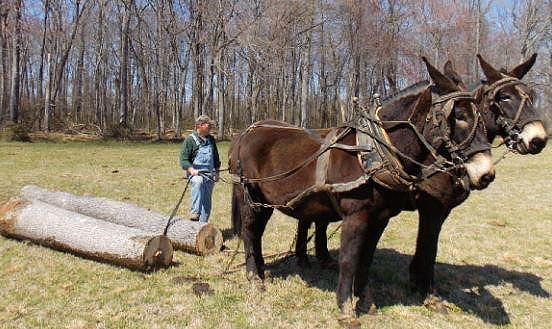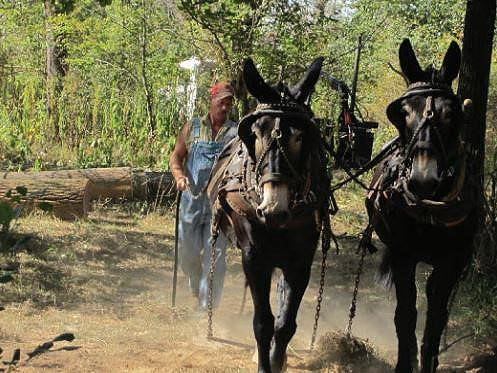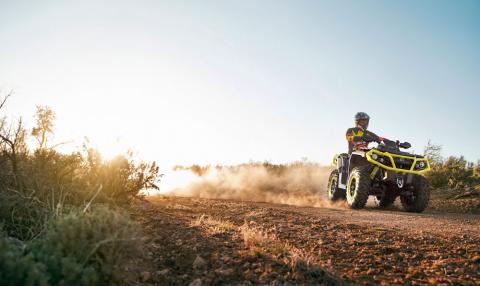Brenda Valentine | Originally published in GameKeepers: Farming for Wildlife Magazine. To subscribe, click here.

“Logging with mules” seems to be in the same category with a “rotary dial phone,” they are still around and just as serviceable as ever but you don't see them much anymore. Speed is usually the motivator of “so-called progress” and without question, modern timbering methods are speedier than a team of floppy-eared mules. The efficiency of today's large-scale logging operations to a huge tract of timber is remindful of an army worm infestation to a lush food plot…both can go from leafy-green to bare dirt overnight. Whereas it could take a couple of tough men and a team of even tougher mules much longer to methodically drag each individual log to a central location for marketing.
Aside from the nostalgic romance of some purist, the soothing rhythm of trace chains jingling, and the big honest eyes of draft animals, there are some very real advantages of muscle-powered mule logging that are of particular interest to many gamekeepers.
Jason McDaniel is a fifth-generation teamster and the youngest member of the Moon, Cox & McDaniel Mule Loggers of Henry County, TN. Four generations of McDaniels continue to live on the Century Farm where they raise fine work stock from sturdy draft mares of mostly Belgium or Percheron decent and handsome, long-eared jacks for the hybrid cross. Each spring the docile mamas and their lanky legged offspring dot the green rolling pastures where the babies will develop quickly. In a couple of years, the young mules are gradually broke to harness and according to their intelligence, strength, and temperament, they might earn a position on the team by the time they reach four or five years old.
Mule loggers such as Jason do not compete with modern mechanical logging, but rather they complement such operations by being able to efficiently take care of small specialty jobs that often require quiet finesse. The typical mule logging job is small acreage. Salvaging storm-damaged trees is a prime example of where this method excels. Sometimes landowners choose to not deal with deep ruts, damage to fences and young trees or plants that are often associated with large logging equipment and opt rather for the shallow round tracks and a few piles of natural fertilizer left behind by these “beasts of burden.”

offspring of a male donkey and a female horse and usually earn a position on the
team by the time they reach 4 or 5 years old.
Jason and his partners often get calls to remove dead or undesirable trees from yards or cultivated fields where the landowner wants limited disturbance to the property. Select thinning for a building site or harvesting a few valuable trees from a woodlot are other applications where the teams are called in. No matter what the requested job may be, it is a guarantee there will always be a few onlookers admiring the ease at which the task is being performed as they enjoy the nostalgia of simpler times. As long as everyone recognizes the dangers of falling trees, audiences are no problem for most of these mules, considering they often do double-duty when they put on fancier harnesses and pull wagons in parades, weddings, and funerals.
The ideal size trees for a two-mule/horse hitch is anything 36 inches across or less at stump height. Larger timber calls for additional horsepower, whereas a four- or six-mule hitch might be used.
A well-cared-for mule can have an average working life of 12-15 years with often several more light-duty retirement years. Mule logging operations are typically small. Two or three men, a team or two of mules, a chainsaw and a log truck is the bulk of the outfit.
The saw man notches and throws the trees then cuts the trunks into 10- or 12-foot long logs. The teamster moves in and drops the log tongs firmly to the end of a log and quietly clucks to the team which is the signal that all is hooked, clear and ready to move. Logs are brought to a central loading location, often near a road or truck-accessible area where they are then loaded and hauled to a sawmill.
Most mule loggers work “on the halves.” This means the landowner and the loggers split whatever money the sawmill pays. This fluctuates according to the current market pricing and the type and quality of the logs.

the mules walk briskly back to fetch another log.
The intelligence of mules is often underrated. What might be mistaken for stubborn ignorance is often an inborn trait of self-preservation and persistence for doing things their way. Most mules have a strong “side preference” which means they work better on the right or left side of the hitch, much like most people are right or left handed. It is not conducive for a smooth work day when a right-side mule is hitched to the left side. A few mules are ambidextrous and that increases their value.
While a standard work harness calls for long reins attached to a bridle and bit, experienced mules work more from voice commands. The universal mule language is "Gee" for a right turn, "Haw" for a left turn, "Ho or Whoa" for stop, and "Come Up” or a “cluck" for go. Most of the time a calm quiet handler will have calm quiet mules that methodically go about their job of dragging heavy logs all day. Man and animals work in unison and become a three-member team.
Two years ago, I contracted Moon and McDaniel Loggers to select-cut a few acres on our farm. This low-lying area surrounded by drainages was ill-accessible and best utilized for wildlife habitat. I wanted all mast-producing trees left to flourish. These included wild cherry, hickory, black walnut, swamp, and white oak. Out came the sycamore, elm, maple, and box-elder. This simple three-day project opened the canopy to sunlight allowing grasses and forbs to boom. It quickly became a preferred deer bedding and browsing area in addition to prime wild turkey nesting the following spring. The select trees that remain do not have to compete for soil nutrients, water or sunlight and will, therefore, improve fruit productivity. This job was not about selling valuable timber for a profit; however, removing the unwanted trees did fetch several dollars that I was able to apply to other gamekeeping projects.
In today's fast-paced world the majority of agriculture and logging operations are run on diesel-power and computer-equipped machinery. I found logging with mules to be a gratifying experience so much like all of my other farming for wildlife measures. It is the satisfaction of the work of enhancing the habitat for the well-being of wildlife that makes us "gamekeepers" and the pleasure of seeing the results that keep us inspired to continue.































